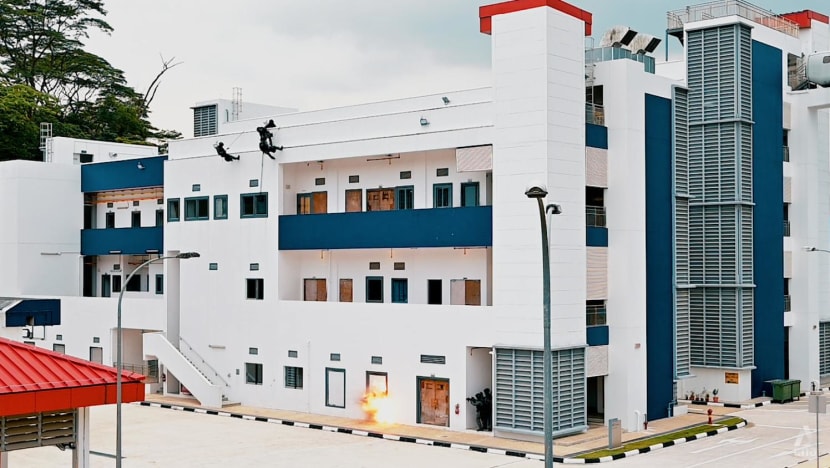How the elite police STAR unit takes down a gunman and rescues hostages
The Singapore Police Force's Special Tactics and Rescue (STAR) Unit is trained to handle armed assailants, hostage rescue operations and high-risk prisoner escorts.

Special Tactics and Rescue (STAR) officers demonstrate the use of explosives to breach a building. (Photo: CNA/Hanidah Amin)
SINGAPORE: The gunman stood alone in an empty room, looking around for any sign of intruders. Quietly, unknown to him, a black robot no bigger than a shoe rolled into an adjacent room.
A drone robot followed, flying in through an open window and approaching the doorway of the room where the gunman stood.
It stopped there, hovering like a hummingbird, and turned 360 degrees as it scanned the vicinity for the gunman's location and any accomplices and hostages.


The drone was transmitting that intel to elite officers from the Special Tactics and Rescue (STAR) Unit who were waiting just around the corner, out of the gunman's sight.
At an officer's command, a police K-9 dog dashed into the location, following the drone into the room where the gunman was.
The hound sank its fangs into the gunman's arm, forcefully pulling him to the floor as officers pushed in to disarm and take him into custody.

The dog's bite would ordinarily have drawn blood and screams of pain. Fortunately for the "gunman", he was wearing thick protective gear in this demonstration of police capabilities.
The lone gunman scenario was the first time STAR was demonstrating a joint deployment of robotics and police dogs – options that allow the team to reduce the risks to its officers.
The STAR unit, which trains at the Home Team Tactical Centre, on Apr 19 gave the media a look at how its officers defuse dangerous situations.
A DEDICATED TACTICAL UNIT
The unit is one of three main divisions in the Special Operation Command – the police's strategic force that also includes the Police Tactical Unit and Police K-9 Unit.
STAR provides the highest level of tactical armed response in the Singapore Police Force.
Before its formation, the Police Tactical Team formed in 1978 was responsible for combating violent crime. But evolving threats led to the conclusion that a dedicated tactical unit with specially trained officers was needed. STAR was formed in 1993 to fill that role.

Officers have to undergo a strenuous training and selection process, followed by advanced training to gain more specialised skills.
They are trained to deal with armed assailants, conduct hostage rescue operations on land and at sea, perform high-risk prisoner escorts and undertake protective security operations.
For a taste of the strength and skill required, this reporter tried on an officer's tactical vest, which can weigh up to 15kg, and gained a pair of sore arms from trying to force open a door with a battering ram.


The STAR unit's capabilities were also on display in another exercise where officers used explosives to breach a building and end a hostage scenario inside.
The operation involved a trio of officers descending to the third floor of the building from the rooftop, coordinating explosives with another group breaching the building from the ground floor.


This reporter initially planned not to wear the ear mufflers provided, in an attempt to feel the scale of the blasts. Fortunately, repeated warnings by police media officers were eventually heeded.
The explosions shook the ground where cameras and crew stood, and sent tremors through the body. After the noise and shock faded, the peaceful afternoon returned as a reminder of what the STAR unit protects.

















